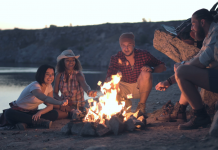Regular exercise has many known physical health benefits, but it also shows to stabilize mood, enhance cognitive function, decrease feelings of anxiety and depression. Studies have shown people who exercise have lower rates of anxiety and depression compared to people who do not exercise.
Nature and mental health, like exercise, can have a positive effect on lowering feelings of stress, anxiety, fatigue, and depression. According to the American Heart Association, exercising outside can help reduce anxiety and stress levels even more than exercising inside.
Most Americans spend most of their time inside with little exposure to nature. Combine the benefits of being outdoors and exercise for mental health by doing these exercises outdoors.
The 8 Best Anxiety Exercises to Do Outdoors
First off, one important consideration for enjoying exercise outside is to dress appropriately. Pay attention to and check the weather before heading outside for a walk or any other exercise.
Specific outdoor dressing considerations include the following:
- If the weather is cooler, dress in layers to stay warm at the beginning then shed layers as needed. Also protect hands, feet, and head by covering them from the cold.
- If exercising in the heat, apply sunscreen before heading out and bring extra water. Wear light, loose fitting clothing to promote optimal body temperature regulation.
- If exercising outdoors as the sun is rising or setting, make sure to wear reflective gear and watch footing.
Geared to work out comfortably, reap the effects of the natural environment with these outdoor exercises!
1. Walking
Walking may be the most practical anxiety lowering exercise to do outdoors. According to the Anxiety and Depression Association of America (ADAA), walking for just 10 minutes may help reduce anxiety and depression as well as a 45 minute workout.
If motivation for getting out the door for exercise is low, shift the focus to completing a 10-minute walk outside. Chances are, you may feel better after 10 minutes and want to continue further!
Remember, start slowly and work up gradually with any exercise outdoors. Gradually progress to 30 minutes or more exercise most days of the week if possible. This can be done in 10 minute increments or in one session.
Overall, it is better to consistently do a little exercise most days than try to load it all up on the weekend.
2. Jogging
There is a major reason people use the term “running for stress relief.”
Aerobic exercise is known to release feel good hormones, also known as endorphins, in the brain. This may be one strong reason why aerobic exercise, like jogging, shows to stabilize mood and lower depression and anxiety.
Aerobic exercise may also provide another way for helping with lowering anxiety. Consistent exercise may actually help the brain endure stress and improve resilience. Over time, this consistent “rewiring” in the brain may help the brain cope with feelings of anxiety and/or depression.
Many who run consistently may say running outdoors provides a unique way to cope with any challenges or concerns. It may not solve any issues, but it provides a space to process things differently and in a different environment.
If unsure on how to start a safe jogging program, consult an exercise specialist. A local running group or online running guide can likewise be helpful.
3. Yoga
Yoga can help naturally lower heart rate, blood pressure and breathing rate which in turn can aid in lowering anxiety. Yoga may be a more appealing form of exercise for stress relief for some, as most forms of yoga intentionally incorporate breathing or meditation throughout exercises.
There are many types of yoga classes that range in physical demand. Like aerobic exercise, some studies have shown yoga to aid in managing stress response.
4. High-Intensity Interval Training
All exercise may provide mental health benefits. However, some studies have shown high-intensity interval exercise (HIIT) reduces anxiety the most, especially in women. The anxiety lowering effect of high-intensity intervals may be felt an hour or longer after exercise.
High-intensity exercise typically involves doing exercise that elevates heart rate for a short burst of time. This is then followed by a rest period and repeated.
For example, a typical high-intensity interval session may include doing exercises for one minute at a time followed by a 2 minute recovery break. The workout is cycled through for about 20 minutes or longer.
5. Team Sports
Exercising outdoors with others in a team sport may be a preferred way to exercise, and some research suggests doing so may lead to anxiety relief. A 2019 study found individual sport athletes were more likely to report anxiety compared to those in team sports.
Team sports can offer a way to break social isolation and a way to participate with others in a friendly competition for a common goal. Check local listings for adult leagues of soccer, basketball, volleyball, dodgeball, flag football, or other team sports.
6. Cycling
Another way to enjoy the outdoors while getting some aerobic exercise is with a bike. Cycling offers the opportunity to travel longer distances in a shorter period of time compared to walking or running. For those with any knee or hip problems, cycling may be a safer, more comfortable way to exercise.
Practice safe outdoor cycling by:
- Wearing protective gear
- Following local safety laws on streets
- Using trails or bike paths when available and as much as possible
Also just like walking or jogging, gradually work up to increasing time and/or intensity on the bike.
7. Dancing
Dance may be an effective way to treat anxiety, as dancing can be used as an outlet for creative expression and/or reduce stress from anxious thoughts.
Dance therapy is done with a dance movement therapist and may be best for those suffering from PTSD and other forms of trauma.
If enjoying dancing and finding it stress relieving, use dance as a form of exercise alone or as part of a group. If dancing outside sounds intimidating and slightly embarrassing, try finding a quiet, secluded place in nature.
8. Breathing Exercises
Slowing heart rate and breathing rate can be key to calming anxiety quickly. Simply getting outside and practicing breathing exercises may be the most beneficial anxiety exercise to feel immediate relief. For individual recommendations for lowering anxiety and best breathing exercises to implement, consult a healthcare professional.
Deep breathing or 4-7-8 breathing are commonly suggested breathing exercises and can be done while laying in the grass or other calming space outside. The 4-7-8 method includes breathing in through the nose for 4 seconds, holding for 7 seconds then breathing out through the mouth for 8 seconds.
Overall, seek out professional guidance if managing an anxiety disorder, depression, or other mental health or mood disorder. While these outdoor exercises can be helpful, they should not replace treatment from a licensed professional.
References:
Exercise for Stress and Anxiety. Anxiety and Depression Association of America, ADAA. https://adaa.org/living-with-anxiety/managing-anxiety/exercise-stress-and-anxiety.









